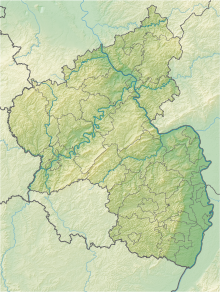Kranichwoog
Coordinates: 49 ° 24 ′ 46.9 ″ N , 7 ° 29 ′ 48.5 ″ E
The Kranichwoog , also known as Hütschenhausener Woog , is a nature conservation project by NABU Rhineland-Palatinate in the municipality of Hütschenhausen in the district of Kaiserslautern , which is intended to offer various animal species a new habitat and resting place.
location
The Kranichwoog is part of the FFH area Westricher Moorniederung , in the landscape protection area Landstuhler Bruch - Oberes Glantal between the nature protection areas Scheidelberger Woog in the west and Schachenwald in the east as well as between the places Hütschenhausen in the north and Hauptstuhl in the south. It consists of two artificially created shallow water basins with a size of around six football fields and three small ponds.
goal of the project
The drainage and intensive cultivation of the Westrich moorland, on the southwestern edge of which the Kranichwoog lies, led to a sharp decline in amphibians and species of birds , butterflies , grasshoppers and dragonflies that are bound to the wetlands in this area . For this reason, artificial shallow ponds were created in the Kranichwoog, which are intended to provide new living space for these animal species. The area is also intended to serve as a resting place for migratory birds - including cranes , after which it is named.
The project is also intended to serve nature-related tourism and environmental education . However, it should only be possible to observe the animals from a greater distance so as not to disturb them.
Emergence
The establishment of the Kranichwoog goes back to an initiative of the NABU local group Weilerbach in 2012. In 2013 a water management feasibility study was carried out which confirmed the current location as the most suitable. Implementation of the project began in 2017. It was financed from funds from the Joint Task for Agricultural Structure and Coastal Protection (GAK). The federal government and the state of Rhineland-Palatinate funded the project with a total of 600,000 euros at a ratio of 60 to 40. The construction work ended in October 2019. On March 12, 2020, the completed project was officially completed on site by District Administrator Ralf Leßmeister , the Rhineland-Palatinate Environment Minister Ulrike Höfken and Cosima Lindemann, Chairwoman of NABU Rhineland-Palatinate, presented.
More plans
In the future, a grazing belt is to be created around the shallow ponds. Grazing should prevent the area from overgrowing with reeds or trees. Carpathian water buffaloes are to be settled in the Kranichwoog in 2020 .
To enable the animals to be observed from a safe distance, at least two observation towers should be built.
See also
Web links
- Articles on the topic of Kranichwoog Hütschenhausen. In: wochenblatt-reporter.de. Retrieved April 11, 2020 .
- newsletter December 2016. (PDF) Stiftung Natur und Umwelt Rheinland-Pfalz, accessed on April 10, 2020 .
- Stopover at Kranichwoog in Hütschenhausen in the SWR media library, available until March 12, 2021
Individual evidence
- ↑ a b Inauguration of the exemplary nature conservation project "Kranichwoog" in Hütschenhausen. In: District of Kaiserslautern. March 12, 2020, accessed April 10, 2020 .
- ↑ a b Stephanie Walter: "Nature can come". In: wochenblatt-reporter.de. March 12, 2020, accessed April 10, 2020 .
- ↑ a b c Höfken: "The Kranichwoog is creating a new biodiversity hotspot". March 11, 2020, accessed April 10, 2020 .
- ^ Service center for the rural area of the West Palatinate: excursions to the Landtuhler Bruch. September 27, 2017, accessed April 10, 2020 .
- ↑ a b Hütschenhausen: The rain fills the Kranichwoog. In: The Rhine Palatinate . October 10, 2019, accessed April 10, 2020 .


